If you do any form of tourism marketing – destination, hotel, cruise line, attraction, tour company, whatever – you know that your number one job is to inspire the itch to travel. Further, you want to persuade people to travel to/with YOU. This job is made infinitely harder by humans’ short attention spans. You’ve only got a moment (or less) to catch their interest. Here are four tips for persuasive tourism marketing writing, so you can leverage that precious moment.
Choose meaningful, rich descriptors that tell a story without you having to explain.
I’ll never forget this ad I saw years ago for the (former) corporate travel booking app Lola:
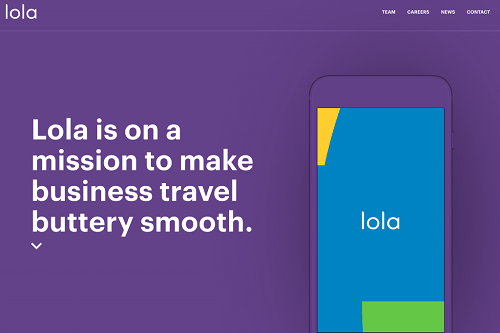
Buttery smooth? That is the most delightful way of saying “no hassles, no mistakes, no friction, no inefficiency, and no logistical nightmares” I’ve ever seen. It evokes a silky, luxurious feeling. As a frequent business traveler, you can be damn sure I want all my trips to be buttery smooth. Who wouldn’t?
If you choose words that – by their very connotation – help articulate the story you’re trying to tell, you’ll have to use far fewer of them to get your point across. How do you find these descriptive gems? It just takes patience and a thesaurus. It’s worth investing the extra time to select the words that will hook your audience with a powerful image.
Skip the details and capture imagination first with a punchline that resonates.
The best example of this has GOT to be the marketing campaign Las Vegas, NV first introduced in 2002:
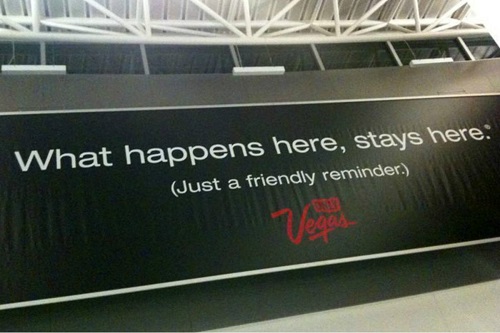
That single sentence says: “when you’re here, you can step outside your normal life and go wild, have fun, behave differently, be a little naughty, take a few risks, make outrageous memories, do things your friends and family would never in a million years think you would do. And then when it’s over, you can go back to your uneventful life and we’ll keep your delicious secret.” What happens here, stays here.™ says ALL THAT in just five words.
That “aspirational punchline” writing style works well in tourism marketing. Many people use travel as a way to reset their lives, shed frustrations, experience new things, and escape tedious daily routines. Marketing slogans used in campaigns are naturally one way to tap this style…slogans lend themselves well to punchlines. You’ll never want to leave. Find yourself here. Come back new. Paired with imagery that nods to the underlying story, this type of punchline crisply delivers the benefit you’ll experience with that journey.
But slogans aren’t the only way to leverage the aspirational punchline writing style. Social media captions are a perfect channel for it. I remember seeing an Instagram post a few months ago for a quintessential New England inn. It featured a carousel of charming inn-and-surrounding-area photos…the covered bridge blanketed with fresh snow, the magical twinkling lights at night on Main Street, the horse-drawn sleigh rides, etc. And the caption simply said: Vacation in a snow globe. I hate being cold, and yet suddenly I wanted to buy a pair of cute furry boots and catch snowflakes on my tongue while drinking hot cocoa wrapped in a plaid blanket during a sleigh ride. But I read that sentence after seeing those photos and I literally pictured myself inside a snow globe.
Use FOMO wisely.
Fear Of Missing Out can be a huge motivator in any purchase decision, but it’s especially useful to writers in hospitality and tourism marketing. One obvious place for inserting copy that pokes someone’s FOMO nerve is in the booking process. Seeing that there are “only 5 rooms left” or that “47 people looked at this deal in the past hour” or that “only 2 dates remain at that price” really creates a sense of urgency. If the person is wrestling with indecision, FOMO can nudge them over the edge.
But the booking process isn’t the only place in the travel decision-making journey where evoking FOMO is a useful writing tool. People will often play out in their minds how they’ll share an experience on social media with friends…BEFORE they’ve even booked the trip. They picture themselves taking THAT selfie, or THAT food photo, or proving they were on THAT adventure. Lean into that sometimes. “Make your friends jealous.” “We only have 10 cabanas. Is one of them reserved for you?” “Instagram was made for this view.”
In a more dramatic example, a restaurant in Freedom, ME puts FOMO at the very core of their entire marketing strategy. The Lost Kitchen is an intimate seasonal restaurant that seats only 48 people per night. And to snag one of those coveted reservations, you have to enter their annual lottery by sending in a postcard.
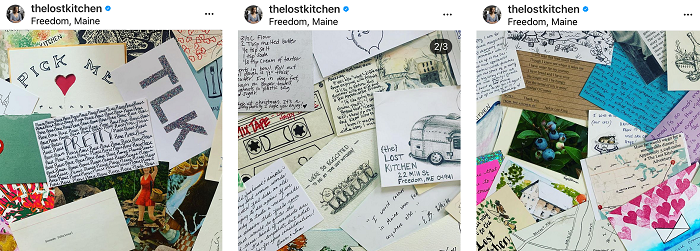
The restaurant receives more than 20,000 postcards each year for those precious few seats. Oh, and to know when it’s time to send it, you need to follow their socials and sign up for their newsletter. FOMO marketing at its finest. <chef’s kiss>
Pair words with imagery that tells most of the story.
If you look at these images of the Faroe Islands, what comes to mind?
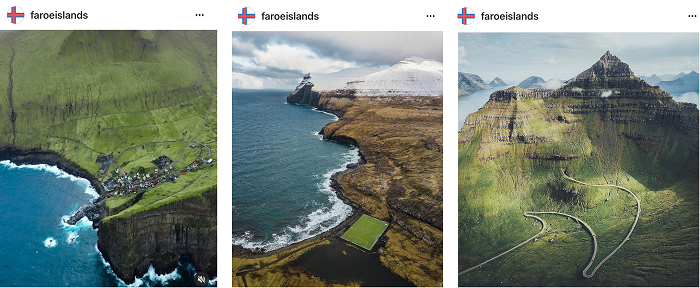
Using such images, they never EVER have to say things like this in their copy: remote, peaceful, breathtaking, natural landscape, small villages, wide open spaces, the opposite of big city life, undiscovered, fresh air, enviable and memorable vacation photos, not a tourist trap, crashing surf, unspoiled, vast, and dramatic views. I hate to say it, but they could even simply write “come visit” as the caption for these photos and it would still work. Words can be powerful and persuasive, yes. But in tourism, often the visuals do the heavy lifting on persuasion. That isn’t even the official tourism account of Visit Faroe Islands and I still want to go.
While it’s true that the Faroe Islands has a built-in advantage on the dramatic imagery game, other types of visuals can lift the persuasive burden off words. In a much less dramatic example, take a peek at Charleston, SC’s Instagram feed. Every Wednesday brings a photo of a flower-filled window box that can be found hanging outside buildings throughout the city, using essentially the same exact caption: “Happy #WindowBoxWednesday from Charleston!”
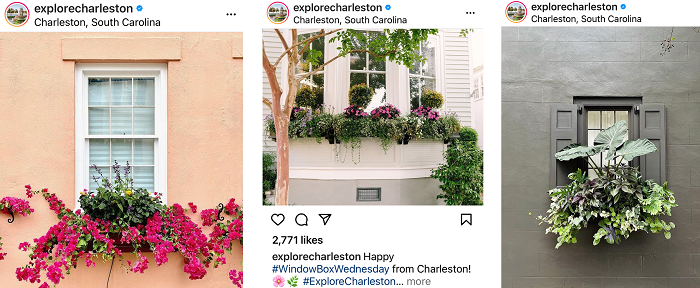
That consistent pairing of photo-and-caption does several things. It positions Charleston as a charming neighborhood where pleasant strolls can be taken. It gives the impression that Charleston is awash with flowers at every turn. It evokes the image of a welcoming and neighborly small town.
There’s something about window boxes that make a place seem more friendly and filled with personality. A single window box does that for a single house. So, collectively, hundreds of window boxes achieve that same goal for a destination. And the copywriting team barely has to write a word about it.
Does it work? You bet it does. I’ve been dreaming about planning a trip to Charleston and – after following their Instagram for so long – it actually crossed my mind to try to go when the window boxes are at their most colorful. And I’m not even a gardening enthusiast!
If you want to up your photography game to give your copy a better assist, see here to learn secrets of a great tourism photo.
And if you’re looking for more inspiration beyond these four writing tips to help make your tourism marketing more persuasive, here’s a handy resource: Copywriting Examples. Bless the gent who pulled all those examples together on one website and made all those teachable moments sortable.
 get travel marketing tips
get travel marketing tips 




